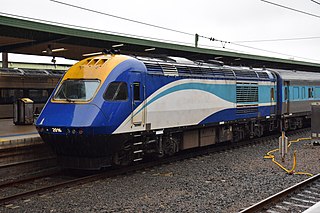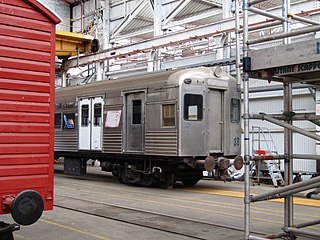
A railcar is a self-propelled railway vehicle designed to transport passengers. The term "railcar" is usually used in reference to a train consisting of a single coach, with a driver's cab at one or both ends. Some railway companies, such as the Great Western, termed such vehicles "railmotors".

The ADK class are a class of diesel multiple units that were previously operated by Western Australian Government Railways (WAGR) in Perth, and later Transdev Auckland on Auckland's suburban rail network, and are currently operated by MetroBus in Maputo, Mozambique. Originally built by Commonwealth Engineering and the Midland Railway Workshops for WAGR in the late 1960s, all but one were sold in 1993 to New Zealand Rail, and were then owned by Auckland Transport. The units were completely withdrawn from service in New Zealand on 5 December 2014, following completion of electrification of Auckland's network.
Railmotor is a term used in the United Kingdom and elsewhere for a railway lightweight railcar, usually consisting of a railway carriage with a steam traction unit, or a diesel or petrol engine, integrated into it.

Commonwealth Engineering, often shortened to Com-Eng, later known as Comeng [ KOM-enj], was an Australian engineering company that designed and built railway locomotives, rolling stock and trams.
The railways of New South Wales, Australia, use a large variety of passenger and freight rolling stock. The first railway in Sydney was opened in 1855 between Sydney and Granville, now a suburb of Sydney but then a major agricultural centre. The railway formed the basis of the New South Wales Government Railways. Passenger and freight services were operated from the beginning. By 1880, there was a half hourly service to Homebush.

The New South Wales XPT is a class of diesel-powered passenger trains built by Comeng and ABB. Based on the British Rail-designed High Speed Train, each XPT set comprises two XP power cars in a push-pull configuration and, between them, between four and seven passenger carriages.

The Tait trains were a wooden bodied electric multiple unit (EMU) train that operated on the suburban railway network of Melbourne, Victoria, Australia. They were introduced in 1910 by the Victorian Railways as steam locomotive hauled cars, and converted to electric traction from 1919 when the Melbourne electrification project was underway. The trains derived their name from Sir Thomas James Tait, the chairman of commissioners of the Victorian Railways from 1903 to 1910. The first cars were built during 1909 with the last entering service in 1952.

The Gulflander is a passenger train operated by Queensland Rail on the isolated Normanton to Croydon line in the Gulf Country of northern Queensland, Australia.

The Silver City Comet was a train service that operated from September 1937 until November 1989 between Parkes and Broken Hill in western New South Wales. It was the first air-conditioned train in Australia.
The MT type carriages were railmotor trailers, used on the Victorian Railways (VR) in Australia.
The New Deal for Country Passengers was a timetable introduced on 4 October 1981 in Victoria, Australia which revolutionised the provision of country passenger railway services in that state. Thirty-five little-used passenger stations were closed, rolling stock utilisation was improved, and new rolling stock introduced. The timetable and associated service changes resulted in an average patronage growth of 8.7% per year, from 3 million in 1981 to 5.6 million passengers in 1990/91.
This article lists some of the terminology used at present and in the past by Australian railway employees, contractors, railway historians and railway enthusiasts. Many of the terms appear from time to time in specialist, rail-related publications.

Tulloch Limited was an Australian engineering and railway rolling stock manufacturer, located at Rhodes, New South Wales.

The 600/700 class railcars are a class of diesel multiple unit built by the New South Wales Government Railways. They were built to operate on branch lines from 1949 with low traffic volumes later being transferred to Newcastle and Wollongong to operate suburban services until withdrawn in 1994. However, one 600 class railcar was converted to solar operation for use on the Byron Bay Train service. The upgraded train entered service on 16 December 2017 and is believed to be the world's first solar-powered train.

A steam railcar is a rail vehicle that does not require a locomotive as it contains its own steam engine. The first steam railcar was an experimental unit designed and built in 1847 by James Samuel and William Bridges Adams. In 1848, they made the Fairfield steam carriage that they sold to the Bristol and Exeter Railway, who used it for two years on a branch line.
The 1100 class railcar or Budd railcar were a type of diesel railcar built by Commonwealth Engineering for the Department of Railways New South Wales in 1961. They primarily operated on the South Coast Daylight Express until withdrawn in 1993.
The New South Wales stainless steel carriage stock was a type of passenger carriage operated by the New South Wales Government Railways from 1961 until 1993.

The SX carriages were a type of passenger carriages constructed by Commonwealth Engineering for the Queensland Railways in 1961–1962.

The WAGR WCA class railcars and WCE class trailers were built by Comeng, Granville for the Western Australian Government Railways in 1971 to operate the new Prospector service between East Perth and Kalgoorlie. At the time of their construction the WCA class units were the longest and fastest diesel railcars in the world.
The NDH class railcars are a class of self propelled diesel-hydraulic railcars designed by Commonwealth Engineering and built by the Gloucester Railway Carriage & Wagon Company in England for the Commonwealth Railways, Australia in 1954. They were known as Gloucester railcars.














